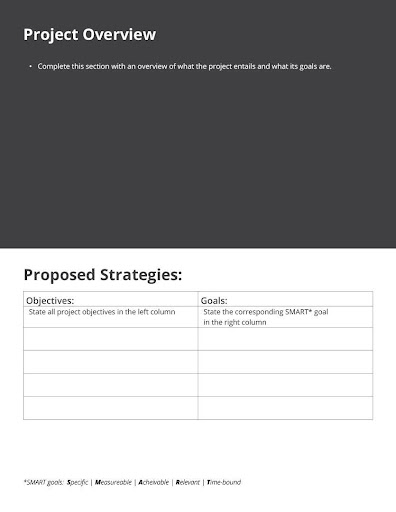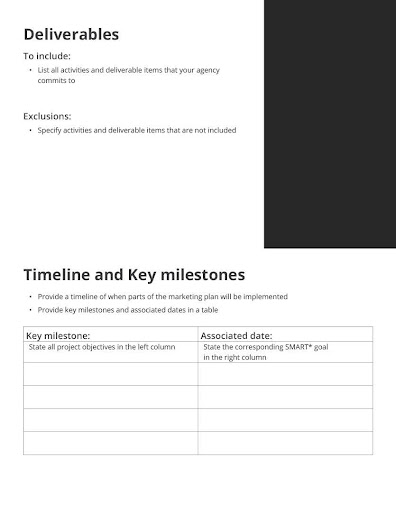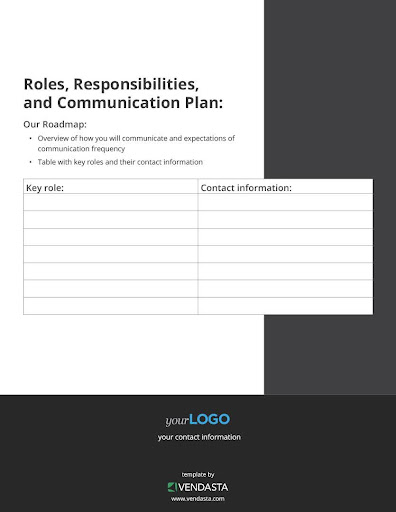Unlocking Project Precision with a Marketing Scope of Work
Having a client project extend far beyond its initial scope is a headache just about every seasoned marketer experiences eventually. It isn’t just inconvenient and time-consuming: it can seriously cut into your profits by using resources that weren’t built into the project budget and taking you away from other tasks, like networking and sales.
Help your clients make the move to digital. Download “Lessons from the digital chasm” to learn data-backed tips for boosting small business tech adoption.
Luckily, this common problem can be prevented even if you’re a startup agency by implementing the use of marketing scope of work (SOW) documents in your agency’s onboarding process.
What is a marketing scope of work?
A marketing SOW is an overview of everything your marketing company will do for a given marketing project, along with other key information like timelines, costs, and primary contacts. As a clear statement of what’s included in a service, it helps clients and agencies get aligned on the specifics of their collaboration. It also protects the client-agency relationship from the damage inflicted by miscommunication.
If you’re growing your agency and don’t regularly use SOWs in your workflow, this blog is for you: we’ll cover everything included in this business document, the benefits of using one that you may not have thought of, and tips for creating the perfect SOW for your business. Stick around for a free marketing scope of work template at the end.
What’s included in a marketing scope of work?
In the context of digital marketing, a scope of work is a document that outlines the work to be done on a given client project or contract. It specifies both what’s included and what’s excluded, ensuring that clients don’t add extra tasks as the project goes on—a phenomenon known as scope creep.
Using a marketing scope of work is an excellent way to protect your time, resources, and client relationships by setting clear objectives and expectations for everyone involved, no matter which niche you work in. It also protects the client, since it formalizes your commitment to a list of deliverables.
Typically, a scope of work will include the following components:
- Project overview: Briefly outline the purpose and goals of the marketing project based on your conversations and negotiations with the client.
- Objectives and goals: Define the specific objectives and goals of the project clearly and measurably. There shouldn’t be much room for interpretation here; the more quantifiable your goals are, the better. Particularly with new clients, it’s impossible to know their assumptions, so clarity is the name of the game.
- Deliverables: Provide a detailed list of the outcomes the client can expect from working with your digital agency. Specify the agency services that will be delivered on their project.
- Exclusions: Exclusions aren’t always included in SOWs, but it’s a good idea to incorporate this section in yours. It helps you get ahead of potential disagreements by specifying what falls outside the scope of the project. For example, if you have a website agency, you might list additional revisions after the design has been signed off under exclusions.
- Timeline and key milestones: Establish a realistic timeline for all deliverables, along with key milestones for project progression. This will help both parties understand if the project is on track or veering off course.
- Roles and responsibilities: Define the roles and responsibilities of both the client and the agency. Listing specific individuals in both businesses along with their responsibilities is a good way to establish accountability.
- Budget allocation: Break down how the client budget will be used. Specify the package costs associated with each part of the project. This establishes transparency and helps clients understand where their money is going. It also helps you understand your cash flow, whether you're managing startup costs or scaling your business.
- Communication plan: Outline the communication channels you and your client have agreed to use and state the expected frequency of updates and client feedback.
Benefits of using a scope of work with clients
This simple, standard document can help prevent some of the biggest headaches experienced by all types of agencies; incorporating a marketing scope of work into the start of each project is a no-brainer. Here are some of the main reasons we’re huge SOW advocates:
- It aligns agency and client on project goals: You can save hours of frustrating back-and-forth with clients by stating goals clearly from the beginning, leaving no room for misunderstanding.
- It enables management of client expectations: Scope creep is costly and frustrating. Even well-intended clients can be guilty of allowing the scope of a project to grow beyond the initial agreement, and a crystal-clear marketing SOW enables you to nip this problem in the bud and focus on your marketing strategy.
- It saves money: Scope creep is costly, leading to extra staff time, white-label agency fees, and other expenses. A SOW protects your agency or marketing consulting firm from incurring extra costs so you can focus on boosting your revenues.
- It provides a roadmap for project execution: Agencies and clients benefit from having a clear roadmap to ensure the work and deliverables are on track. From boutiques to large agencies, systems are essential to success.
- It allows for clearer communication: Miscommunication can severely damage client relationships, and those relationships are among your most valuable assets. Agencies with no experience often make this mistake: protect yourself from this outcome by leaving no room for miscommunication.
- It enables measurement of success: Clients will appreciate having a roadmap against which to measure progress and gauge their return on investment (ROI).
Tips for a seamless marketing scope of work
Use these tips as a checklist before submitting your next SOW to ensure the best results for your agency and your clients.
1. Clearly define project objectives and goals
Ensure absolute clarity by defining project objectives and goals upfront. This is the first thing your client will read, so it’s important that it accurately reflects the conversations you’ve had up to this point.
2. Conduct research and analysis
By including a research and analysis section in your SOW, you’ll demonstrate that your plans are aligned with realistic market conditions and a solid understanding of your client’s business. It also gives you the best chance of delivering an impressive ROI to your clients, which is key to getting repeat business and referrals.
3. Involve key stakeholders
Multiple stakeholders will likely work on each client project, so collaborating with everyone involved is a must. Involving teammates and agency partners in the scope development process to gather diverse perspectives on the deliverables and foster a sense of ownership. Key stakeholders from the client side should be involved and sign off on the SOW too.
4. Set realistic timelines and milestones
Building a realistic timeline is critical for project success by keeping your team on track and setting client expectations. Define the milestones you’ll use to gauge progress and a time range for when each milestone will be met.
Want to stay on top of your promised timeline? Check out this vlog all about staying on top of sales tasks and customer conversations:
5. Include detailed descriptions of deliverables
This is one of the most important components of a marketing scope of work since it states exactly what clients can expect from trusting you with their project. Be clear with detailed descriptions of deliverables and expected outcomes, and make sure all decision-makers on the client side see it before initiating the project.
6. Define project scope and boundaries
Just as significant as the description of deliverables is the definition of boundaries, scope, and exclusions. This is where you protect your agency from scope creep by defining the project's limits from the outset.
7. Establish a communication plan
Communication is the cornerstone. Establish a robust communication plan to facilitate regular updates and feedback. This not only enhances collaboration but also ensures that everyone remains informed and aligned throughout the project.
8. Consider potential risks and challenges
Experienced marketers are good at anticipating the road ahead. Identifying potential risks and challenges in advance of starting a project allows for proactive mitigation strategies, and building these into your plan gives clients peace of mind. For example, if you deliver pay-per-click advertising, you might include an overview of how you’ll pivot in the event of unsuccessful ad campaigns.
9. Seek client approval and agreement
Finish off by solidifying the client’s commitment. Before project initiation, get approval and agreement on the scope from everyone involved on the client side.
10. Regularly review and update
While the purpose of an SOW is to prevent changes on the fly, many marketing projects are long-term. Checking in periodically to ensure the current scope of the project still works for both parties is important to maintaining long-term satisfaction and maximizing the effectiveness of your agency strategies.
Free marketing scope of work template
If you’re ready to start using a marketing scope of work in your agency, there’s no need to waste your time reinventing the wheel. With this comprehensive template, all you have to do is fill it in with the specifics of your project and customize it to match your agency’s colors, typography system, and logo.
Get the marketing scope of work template here:






